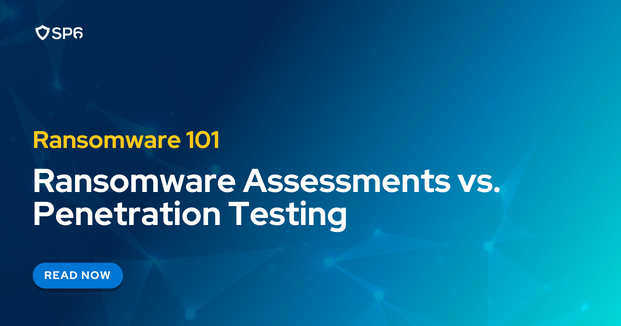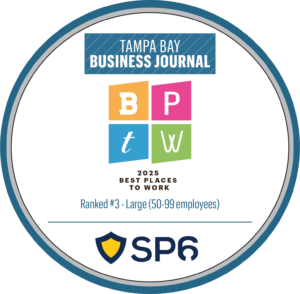With an average price tag of $9.4 million, ransomware has the power to decimate your organization.1 Are you confident that your security controls can hold up against today’s increasingly sophisticated attacks?
The best way to test the effectiveness of your controls is to attack them as an adversary would. But not all attack simulation methods are made equal — particularly when it comes to penetration testing vs. ransomware assessments by SP6.
In this guide, we’ll break down the key differences between the two and equip you with everything you need to know to decide which is right for your organization.
What is Penetration Testing?
Penetration testing, or pen testing, involves human testers manually attempting to find and exploit vulnerabilities in an organization’s systems, networks, or applications. These testers act like malicious actors would and use a variety of tools and techniques to break through pre-existing controls.
Penetration tests are typically conducted with a predetermined goal in mind, such as gaining access to a particular database. By revealing how a threat actor could achieve this, pen tests guide organizations in refining their security controls.
Because penetration testing relies on human testers, it’s resource intensive and typically only targets one area of a network at a time. Pen testing provides a point-in-time, rather than continuous, snapshot of how your controls are operating.
Another approach to penetration testing is automated penetration testing. This methodology still relies on human testers to conduct an attack, but it automates many of the repetitive actions they take along the way, allowing testers to accomplish more in less time.
What are Ransomware Assessments by SP6?
Ransomware assessments, derived from breach and attack simulation technology, are an automatic, continuous way to simulate real-world attacks across your entire security environment. By mimicking attack methods from 300+ known ransomware families, ransomware assessments empower you to find and fix security gaps before adversaries exploit them.
Unlike penetration testing, ransomware assessments don’t rely on human testers. Instead, as former Gartner Vice President, Research Analyst Augusto Barros explains, ransomware assessments “automate the simple pentest, performing the basic cycle of scan/exploit/repeat-until-everything-is-owned … with a simple click of a button.” To do so, they pull from libraries of hundreds of documented attack methods that have been automated.
Ransomware assessments are wider in scope than penetration testing. They aim to not only test the efficacy of individual security controls, but also how the entire security ecosystem responds to a specific attack scenario at each stage of the defense process.
Ransomware assessments are also less resource intensive and are capable of being conducted on a more continuous basis than penetration testing.
Ransomware Assessments vs. Penetration Testing: Why Ransomware Assessments Prevail
Ransomware assessments can be continuous — penetration testing is point-in-time.
One of the biggest pitfalls of penetration testing is that it can only provide a point-in-time snapshot of your security controls. You’ll know that your controls are working today, but what about as you make changes to your environment?
Ransomware assessments are designed to be continuous. Because they’re automated, you can run simulations as frequently as you’d like without needing to invest in additional resources. This allows you to always have an up-to-date picture of how your controls are operating.
Ransomware assessments are automated — penetration testing is human-led.
Penetration testing relies on the expertise of human testers, which often requires a steep monetary and time investment. Having human testers also makes the practice less reliable as the quality of results is tied to the skill level of the tester.
Ransomware assessments, on the other hand, automate the entire test process from start to finish. This reduces costs, makes it more time efficient, and increases scalability, all while providing more reliable results.
Ransomware assessments are larger in scope and scalability than penetration testing.
Another consequence of relying on human testers is that the scope of investigation is limited. To fit within time and budget restraints, penetration tests typically only target a small area of an environment at a time.
With ransomware assessments, the scope is much greater and can easily be scaled up or down through configurations in the central tool. Additionally, ransomware assessments can test lateral movement and privilege escalation independent of a precursory external attack.
Ransomware assessments can be customized to align with business risk.
Because penetration testing is typically done without knowledge of an organization’s network, it cannot be aligned to business risk.
In contrast, ransomware assessments offer the flexibility to customize attack scenarios based on the risks of your unique business environment, such as deploying agents to known sensitive assets to continuously validate their protection.
Ransomware assessments can integrate with security controls to provide recommendations.
Penetration testing has no integration with your security controls, so it can’t suggest things like signatures, hashes, or SIEM detections that would’ve helped stop an undetected attack.
Ransomware assessments do integrate with your SIEM and other security controls. They can report when your SIEM detects a simulation, suggest rules to solve for undetected simulations, and recommend other ways to optimize your controls.
Unlike penetration testing, ransomware asessments are meant to be a continuous, operational tool for the SOC to use day in and day out. They’re a purple-teaming exercise, whereas penetration testing is purely a red-teaming exercise.
Conclusion
Although penetration testing will always be a valuable practice, ransomware assessments offer clear advantages when it comes to improving your protection against ransomware. They’re significantly cheaper, less resource intensive, and quicker. Additionally, they’re continuous, more reliable, wider in scope, better tied to business risk, and more cable of integration than penetration testing.
Ready to discover the gaps in your ransomware defenses? Start a conversation with SP6 today, or learn more about our ransomware assessments.
1 Cost of a Data Breach Report 2022, Ponemon Institute, IBM.


